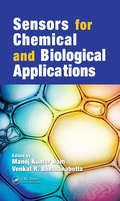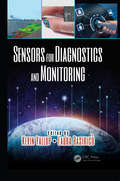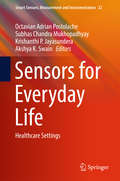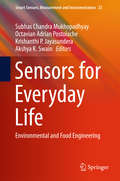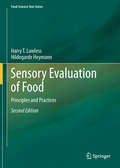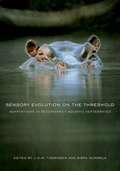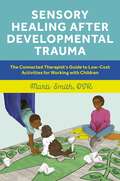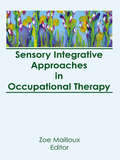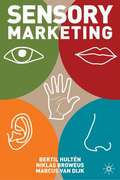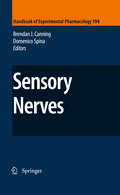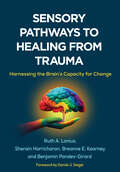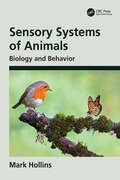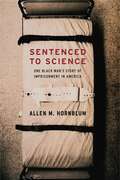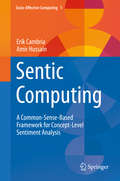- Table View
- List View
Sensors for Chemical and Biological Applications
by Venkat R. Bhethanabotla Manoj Kumar RamIn recent years, sensor research has undergone a quiet revolution that will have a significant impact on a broad range of applications in areas such as health care, the environment, energy, food safety, national security, and manufacturing. Sensors for Chemical and Biological Applications discusses in detail the potential of chemical and biological sensors and examines how they are meeting the challenges of chem-bio terrorism by monitoring through enhanced specificity, fast response times, and the ability to determine multiple hazardous substances. Exploring the nanotechnology approach, and carrying this theme throughout the book, the chapters cover the sensing principles for, chemical, electrical, chromatographic, magnetic, biological, fluidic, optical, and ultrasonic and mass sensing systems. They address issues associated with cost, synthesis, and testing of new low cost materials with high sensitivity, selectivity, robustness, and speed for defined sensor applications. The book extensively discusses the detailed analysis of future impact of chemical and biological sensors in day-to-day life. Successful development of improved chemical sensor and biosensor systems and manufacturing procedures will not only increase the breadth and depth of the sensor industry, but will spill over into the design and manufacture of other types of sensors and devices that use nanofabrication and microfabrication techniques. This reference not only supplies versatile, hands-on tools useful in a broad array of disciplines, but also lays the interdisciplinary groundwork required for the achievement of sentient processing.
Sensors for Diagnostics and Monitoring (Devices, Circuits, and Systems)
by Kevin Yallup Laura BasiricòSensor technologies and applications are evolving rapidly driven by the demand for new sensors for monitoring and diagnostic purposes to enable improvements in human health and safety. Simultaneously, sensors are required to consume less power, be autonomous, cost less, and be connected by the Internet of Things. New sensor technologies are being developed to fulfill these needs. This book reviews the latest developments in sensor technology and gives the reader an overview of the state-of-the-art in key areas, such as sensors for diagnostics and monitoring. Features Provides an overview of sensor technologies for monitoring and diagnostics applications. Presents state-of-the-art developments in selected topics for sensors that can be used for monitoring and diagnostics in future healthcare, structural monitoring, and smart environment applications. Features contributions from leading international experts in both industry and academia. Explores application areas that include medical diagnostics and screening, health monitoring, smart textiles, and structural monitoring.
Sensors for Everyday Life
by Subhas Chandra Mukhopadhyay Octavian Adrian Postolache Krishanthi P. Jayasundera Akshya K. SwainSensors were developed to detect and quantify structures and functions of human body as well as to gather information from the environment in order to optimize the efficiency, cost-effectiveness and quality of healthcare services as well as to improve health and quality of life. This book offers an up-to-date overview of the concepts, modeling, technical and technological details and practical applications of different types of sensors. It also discusses the trends for the next generation of sensors and systems for healthcare settings. It is aimed at researchers and graduate students in the field of healthcare technologies, as well as academics and industry professionals involved in developing sensing systems for human body structures and functions, and for monitoring activities and health.
Sensors for Everyday Life
by Subhas Chandra Mukhopadhyay Octavian Adrian Postolache Krishanthi P. Jayasundera Akshya K. SwainSensors were developed to detect and quantify structures and functions of human body as well as to gather information from the environment in order to optimize the efficiency, cost-effectiveness and quality of healthcare services as well as to improve health and quality of life. This book offers an up-to-date overview of the concepts, modeling, technical and technological details and practical applications of different types of sensors. It also discusses the trends for the next generation of sensors and systems for healthcare settings. It is aimed at researchers and graduate students in the field of healthcare technologies, as well as academics and industry professionals involved in developing sensing systems for human body structures and functions, and for monitoring activities and health.
Sensors, Nanoscience, Biomedical Engineering, and Instruments: Sensors Nanoscience Biomedical Engineering (The Electrical Engineering Handbook)
by Richard C. DorfIn two editions spanning more than a decade, The Electrical Engineering Handbook stands as the definitive reference to the multidisciplinary field of electrical engineering. Our knowledge continues to grow, and so does the Handbook. For the third edition, it has expanded into a set of six books carefully focused on a specialized area or field of study. Each book represents a concise yet definitive collection of key concepts, models, and equations in its respective domain, thoughtfully gathered for convenient access.Sensors, Nanoscience, Biomedical Engineering, and Instruments provides thorough coverage of sensors, materials and nanoscience, instruments and measurements, and biomedical systems and devices, including all of the basic information required to thoroughly understand each area. It explores the emerging fields of sensors, nanotechnologies, and biological effects. Each article includes defining terms, references, and sources of further information. Encompassing the work of the world’s foremost experts in their respective specialties, Sensors, Nanoscience, Biomedical Engineering, and Instruments features the latest developments, the broadest scope of coverage, and new material on multisensor data fusion and MEMS and NEMS.
Sensory Evaluation of Food
by Hildegarde Heymann Harry T. LawlessThis volume covers all the basic techniques of sensory testing, from simple discrimination tests to home use placements for consumers. It provides fundamental theories, psychological and statistical, that form the basis and rationale for sensory test design. Statistics used in sensory evaluation are also demonstrated both as stand-alone material presented in appendices and as integrated applications in the context of appropriate sensory methods. Chapters are constructed so that beginning students who want only the practical aspects of conducting sensory test will see clear instruction on how test should be conducted. Advanced students and practitioners will enjoy the more detailed sections on rationale and related issues.
Sensory Evolution on the Threshold: Adaptations in Secondarily Aquatic Vertebrates
by J. G. M. Thewissen Sirpa NummelaThis synthesis explores the function and evolution of sensory systems in animals whose ancestors lived on land. Together, the contributors explore the dramatic transformation of smell, taste, sight, hearing, balance, mechanoreception, magnetoreception, and electroreception that occurred as lineages of amphibians, reptiles, birds, and mammals returned to aquatic environments.
Sensory Healing after Developmental Trauma: The Connected Therapist’s Guide to Low-Cost Activities for Working with Children
by Marti SmithIn using this resourceful guide, therapists can develop a comprehensive understanding of how trauma impacts their young clients' brains and sensory systems. Filled with therapeutic strategies and activities tailored to specific regions of the brain, professionals will be able to optimise brain rehabilitation and improve sensory processing abilities.The book includes a wide range of low-cost, budgeted activities that can be applied in a variety of settings, including juvenile justice, rehab, schools, homes, residential care, and foster homes, all of which include guidance on how to engage the wider community in order to maximise the potential for healing.Complete with the latest research on trauma and real-life case studies, this book provides an excellent foundation on understanding the science and applying it in practice. It is an indispensable resource for paediatric caregivers looking to support the children they're working with in healing the impact of trauma.
Sensory Integrative Approaches in Occupational Therapy
by Florence S CromwellLeading advocates of sensory integration use in occupational therapy explore the exciting potentials of this profound theory and its applications. This truly comprehensive and enlightening book provides step-by-step assistance for therapists in observing patient’s behavior and appropriately modifying the patient’s environment in order to promote increasingly complex adaptive behaviors. Sensory Integrative Approaches in Occupational Therapy moves beyond the traditional use of the practice with the learning disabled elementary school aged child by demonstrating its successful application in programs for infants, preschoolers, adolescents, and the elderly. Occupational therapists with a wide array of clinical, research, and education experience address contemporary issues such as advocacy, cost effectiveness, family participation, and documentation of patient progress. They clearly demonstrate how sensory integration theory complements and mutually reinforces other common occupational therapy practices. This exciting book will stimulate your creativity and encourage the continued development of sensory integration theory as a vital component of occupational therapy in health care.
Sensory Marketing
by Bertil Hultén Niklas Broweus Marcus Van DijkThe book covers the ongoing shift from mass-marketing and micro-marketing to sensory marketing in terms of the increased individualization in the contemporary society. It shows the importance in reaching the individuals' five senses at a deeper level than traditional marketing theories do.
Sensory Nerves
by Domenico Spina Brendan J. CanningThe intention of this book is to provide a comprehensive and contemporary review of the biology of sensory nerves. In keeping with the theme of the Handbook series, an emphasis will be placed on the actions of drugs, transmitters and autacoids that initiate or inhibit sensory nerve activation (through actions on ion channels and receptors at their peripheral terminals) or modulate the release or actions of the transmitters released from the central terminals of sensory nerves. Based on extensive supportive evidence in the literature, it is our view that many diseases are characterised by alterations in sensory nerve function (eg pain, cardiovascular disease, and migraine). It is our belief that this book will be unique, as it will comprehensively cover the role of sensory nerves across many therapeutic areas.
Sensory Neuroscience: Four Laws of Psychophysics
by Jozef J. ZwislockiSensory Neuroscience: Four Laws of Psychophysics organizes part of psychophysics -- a science of quantitative relationships between human sensations and the stimuli that evoke them. Although psychophysics belongs to sensory neuroscience, and is coupled to neurophysiology, it has also branched out to various specialized disciplines, including the disciplines of vision and hearing, ophthalmology, optometry, otology, and audiology. Due to this diversification and fragmentation, psychophysics has had an ad-hoc, phenomenological orientation. Besides Weber's law of differential sensitivity, and the still-controversial Stevens' power law, it has lacked a systematic grid of scientific laws. Sensory Neuroscience: Four Laws of Psychophysics provides valid unifying principles and systematic applications for this otherwise fragmented precursor of experimental psychology, and defines four multisensory relationships of substantial generality between sensations and the underlying stimulus variables. This book will be particularly useful to auditory researchers, experimental psychologists, and behavioral neuroscientists.
Sensory Pathways to Healing from Trauma: Harnessing the Brain's Capacity for Change
by Ruth A. Lanius Sherain Harricharan Breanne E. Kearney Benjamin Pandev-GirardThis forward-thinking book explores the impact of psychological trauma on the brain's sensory pathways and demonstrates the crucial role sensory-based interventions can play in recovery. Ruth A. Lanius and associates interweave neurobiological research with evocative case examples and narratives from survivors. The book shines a spotlight on the brain–body disconnect that is part of the lived experience of trauma, and traces what happens in all eight sensory systems when an individual is under threat. Featuring "Bridging to Practice" sections in each chapter, the book reveals how working with sensory pathways can engage the whole brain, promote neuroplasticity, and optimize the effectiveness of standard psychotherapies. Illustrations include eight pages in full color.
Sensory Science and Chronic Diseases: Clinical Implications and Disease Management
by Paule Valery Joseph Valerie Buzas DuffyThe textbook provides an overview of the sensory science field in the context of diseases such as obesity and Coronavirus disease 2019 (COVID-19). This book brings a summary of the state of the science in key areas and provides examples of translational science from using cellular and rodent models to human clinical trials and community health. The volume structure leads the reader through the physiology of taste and smell into how sensory testing for taste and smell is studied, basic mechanisms, various protocols that are used throughout the field along with the pros/cons of the current methods used. This resource is intended for classroom teaching, for novice researchers in sensory research as well as students and postdoctoral fellows. Example of courses are nutrition, basic nursing, interdisciplinary health courses, sensory perception (psychology), neuroscience, and medical courses, dentistry, food science and others.
Sensory Systems of Animals: Biology and Behavior
by Mark HollinsPerception in animals is a fascinating and challenging subject that calls to students from many disciplines. The aim of this book is to provide a knowledge base and unifying perspective on the field that will enable beginning researchers to chart their own course within it. The author describes, in a systematic but engaging way, the sensory systems of humans and other vertebrates, as well as arthropods and molluscs.Why is it important to understand the senses of animals? One reason is that human activities are changing the perceptual world of animals in ways that expose them to danger. From bright outdoor lighting disorienting migrating birds to human sonar driving whales to beach themselves; it is becoming increasingly important to find ways to reduce such dangers. This will require big changes in human behavior, and greater understanding of how animals react, physiologically and behaviorally, to anthropogenic changes in their environment.The emphasis throughout is on research, in both the behavioral/ethological and neuroscientific traditions, that has led to important discoveries. The functional anatomy of each system, from receptor cells to brain areas, is succinctly described, explaining how it underlies the animal’s sensory abilities and behavior. Overall descriptions of a sense for a class of animals (for example, hearing in arachnids) are interspersed with expanded coverage of that sense in a particular animal, such as the ogre-faced web-casting spider that does a backflip to capture an insect buzzing overhead. Evolutionary themes are found throughout the book, for example in describing the development of the vertebrate ear, and in the convergent evolution of the eyes of vertebrates and cephalopods.With over 500 references and 80 illustrations, this textbook is intended as primary reading for advanced undergraduates and beginning graduate students of biology, neuroscience, sensory psychology, and veterinary science. It will also be of interest to professionals and academics in these fields, and to anyone else who works with or studies animals.
Sensual Rejuvenation: Maintaining Sexual Vigor Through Midlife and Beyond
by Judith SachsDid you know that sex can dramatically boost your overall well-being? If you, like many people, are hitting midlife and feeling that sex is just not what it used to be, think again. While you are experiencing a variety of physical and emotional changes, sex can still be one of the enduring pleasures you can enjoy through midlife and on to your golden years. Now this unique guide provides important information on age-related changes in sexual function and offers a wide range of medical, holistic, and psychological tips and techniques that can relight your fire. Don't miss... Testosterone cream that restores a woman's libido; Zinc, the most important mineral for male potency, and all the must-have nutrients; The best herbal alternatives to Viagra; Ways to fulfill sexual needs if there is illness or disability; The Seesaw and other stimulating exercises to make sex feel great. Find out more in Sensual Rejuvenation.
Sensual Relations: Engaging the Senses in Culture and Social Theory
by David HowesWith audacious dexterity, David Howes weaves together topics ranging from love and beauty magic in Papua New Guinea to nasal repression in Freudian psychology and from the erasure and recovery of the senses in contemporary ethnography to the specter of the body in Marx. Through this eclectic and penetrating exploration of the relationship between sensory experience and cultural expression, Sensual Relations contests the conventional exclusion of sensuality from intellectual inquiry and reclaims sensation as a fundamental domain of social theory. David Howes is Professor of Anthropology, Concordia University, Montreal, Quebec.
Sentenced to Science: One Black Man's Story of Imprisonment in America (G - Reference, Information and Interdisciplinary Subjects)
by Allen M. Hornblum Harriet WashingtonFrom 1951 until 1974, Holmesburg Prison in Philadelphia was the site of thousands of experiments on prisoners conducted by researchers under the direction of University of Pennsylvania dermatologist Albert M. Kligman. While most of the experiments were testing cosmetics, detergents, and deodorants, the trials also included scores of Phase I drug trials, inoculations of radioactive isotopes, and applications of dioxin in addition to mind-control experiments for the Army and CIA. These experiments often left the subject-prisoners, mostly African Americans, in excruciating pain and had long-term debilitating effects on their health. This is one among many episodes of the sordid history of medical experimentation on the black population of the United States.The story of the Holmesburg trials was documented by Allen Hornblum in his 1998 book Acres of Skin. The more general history of African Americans as human guinea pigs has most recently been told by Harriet Washington in her 2007 book Medical Apartheid. The subject is currently a topic of heated public debate in the wake of a 2006 report from an influential panel of medical experts recommending that the federal government loosen the regulations in place since the 1970s that have limited the testing of pharmaceuticals on prison inmates.Sentenced to Science retells the story of the Holmesburg experiments more dramatically through the eyes of one black man, Edward “Butch” Anthony, who suffered greatly from the experiments for which he “volunteered” during multiple terms at the prison. This is not only one black man’s highly personal account of what it was like to be an imprisoned test subject, but also a sobering reminder that there were many African Americans caught in the viselike grip of a scientific research community willing to bend any code of ethics in order to accomplish its goals and a criminal justice system that sold prisoners to the highest bidder.
Sentic Computing
by Amir Hussain Erik CambriaIn this book common sense computing techniques are further developed and applied to bridge the semantic gap between word-level natural language data and the concept-level opinions conveyed by these. In particular, the ensemble application of graph mining and multi-dimensionality reduction techniques is exploited on two common sense knowledge bases to develop a novel intelligent engine for open-domain opinion mining and sentiment analysis. The proposed approach, termed sentic computing, performs a clause-level semantic analysis of text, which allows the inference of both the conceptual and emotional information associated with natural language opinions and, hence, a more efficient passage from (unstructured) textual information to (structured) machine-processable data.
Sentience and Animal Welfare
by Donald BroomSentience - the ability to feel, perceive and experience - is central to the animal welfare debate as it raises the question of whether animals experience suffering in life and death. This book explores and answers these questions in an objective way, based on the latest research and empirical evidence. Beginning with an introduction to sentience, the book investigates why we are so interested in sentience, when, as a species, humans became sentient and how it has changed over time. The book defines aspects of sentience such as consciousness, memory and emotions, and discusses brain complexity in detail. Looking at sentience from a developmental perspective, it analyses when in an individual's growth sentience can be said to appear and uses evidence from a range of studies investigating embryos, foetuses and young animals to form an enlightening overview of the subject. With a full chapter covering ethical decisions such as animal protection and experimentation, this book is not only an invaluable resource for researchers and students of animal welfare and biology, but also an engaging and informative read for veterinarians and the general public.
Sentience and Animal Welfare
by Donald BroomSentience – the ability to feel, perceive and experience – is central to the animal welfare debate as it raises the question of whether animals experience suffering in life and death. This book explores and answers these questions in an objective way, based on the latest research and empirical evidence. Beginning with an introduction to sentience, the book investigates why we are so interested in sentience, when, as a species, humans became sentient and how it has changed over time. The book defines aspects of sentience such as consciousness, memory and emotions, and discusses brain complexity in detail. Looking at sentience from a developmental perspective, it analyses when in an individual’s growth sentience can be said to appear and uses evidence from a range of studies investigating embryos, foetuses and young animals to form an enlightening overview of the subject. With a full chapter covering ethical decisions such as animal protection and experimentation, this book is not only an invaluable resource for researchers and students of animal welfare and biology, but also an engaging and informative read for veterinarians and the general public.
Sentiment Analysis in the Medical Domain
by Kerstin DeneckeSentiment analysis deals with extracting information about opinions, sentiments, and even emotions conveyed by writers towards topics of interest. Medical sentiment analysis refers to the identification and analysis of sentiments or emotions expressed in free-textual documents with a scope on healthcare and medicine. This fascinating problem offers numerous application areas in the domain of medicine, but also research challenges. The book provides a comprehensive introduction to the topic. The primary purpose is to provide the necessary background on medical sentiment analysis, ranging from a description of the notions of medical sentiment to use cases that have been considered already and application areas of relevance. Medical sentiment analysis uses natural language processing (NLP), text analysis and machine learning to realise the process of extracting and classifying statements regarding expressed opinion and sentiment. The book offers a comprehensive overview on existing methods of sentiment analysis applied to healthcare resources or health-related documents. It concludes with open research avenues providing researchers indications which topics still have to be developed in more depth.
Sentinel Node Biopsy in Breast Cancer
by ChintamaniThis book is Concise, portable, and user-friendly. “Sentinel Node Biopsy in Breast Cancer” focuses on the background, evolution, and newer advances in the concepts and techniques of sentinel node biopsy in patients with breast cancer. The authors include global experts in the field from India, the UK, the USA, and other countries to cover up the regional differences and biases and provide clear and evidence-based answers to all aspects focusing on the address of the axilla in breast cancer which is now arguably the most common cancer of the human race. Key features: A detailed and practical approach to the surgical anatomy of axilla An up-to-date review of all landmark trials in the field of sentinel node biopsy This book provides concise guidelines and the algorithmic & step by step approach to various techniques, including recent advances. Explains about limitations and merits of all sentinel node biopsy techniques in breast cancer and the approach to tailoring it to the patient, center, and surgeon.Address of axilla in various resource-constrained scenarios.
Sentinel for Health: A History of the Centers for Disease Control
by Elizabeth W. EtheridgeIn the only history of its kind, Etheridge traces the development of the Centers for Disease Control from its inception as a malaria control unit during World War II through the mid-1980s . The eradication of smallpox, the struggle to identify an effective polio vaccine, the unraveling of the secrets of Legionnaires' disease, and the shock over the identification of the HIV virus are all chronicled here. Drawing on hundreds of interviews and source documents, Etheridge vividly recreates the vital decision-making incidents that shaped both the growth of this institution as well as the state of public health in this country for the last five decades.We follow the development of the institution as it was transformed by the will and the imagination of remarkable individuals such as Dr. Joseph Mountin, one of the first heads of the CDC. Often characterized as abrasive and impatient, Mountin pushed the CDC to become a vital player in eradicating the threat of communicable disease in the United States. Others such as Dr. Alexander Langmuir brought the expertise necessary to establish epidemiology as one of the primary functions of the CDC.Created to serve the states and to answer any call for help whether routine or extraordinary, the CDC is now widely recognized as one of the world's premier public health institutions.
Separate Beds: A History of Indian Hospitals in Canada, 1920s-1980s
by Maureen K. LuxSeparate Beds is the shocking story of Canada's system of segregated health care. Operated by the same bureaucracy that was expanding health care opportunities for most Canadians, the "Indian Hospitals" were underfunded, understaffed, overcrowded, and rife with coercion and medical experimentation. Established to keep the Aboriginal tuberculosis population isolated, they became a means of ensuring that other Canadians need not share access to modern hospitals with Aboriginal patients.Tracing the history of the system from its fragmentary origins to its gradual collapse, Maureen K. Lux describes the arbitrary and contradictory policies that governed the "Indian Hospitals," the experiences of patients and staff, and the vital grassroots activism that pressed the federal government to acknowledge its treaty obligations.A disturbing look at the dark side of the liberal welfare state, Separate Beds reveals a history of racism and negligence in health care for Canada's First Nations that should never be forgotten.
